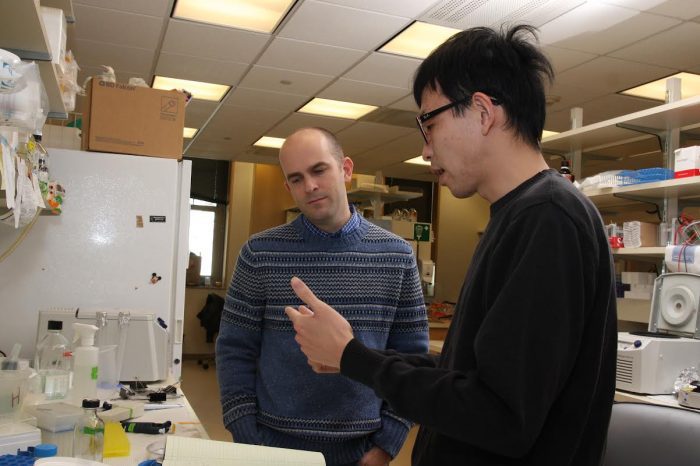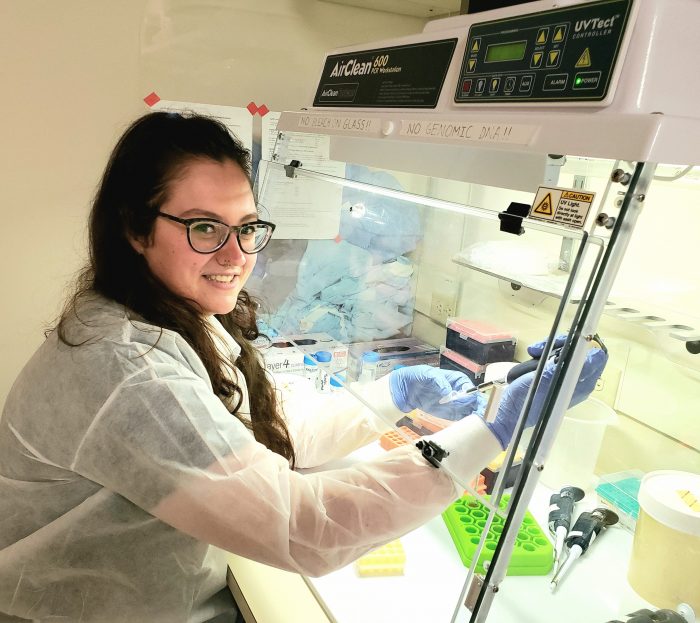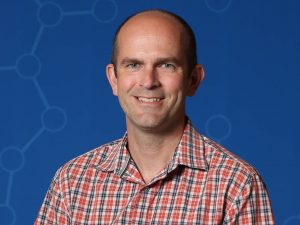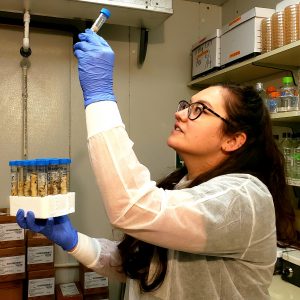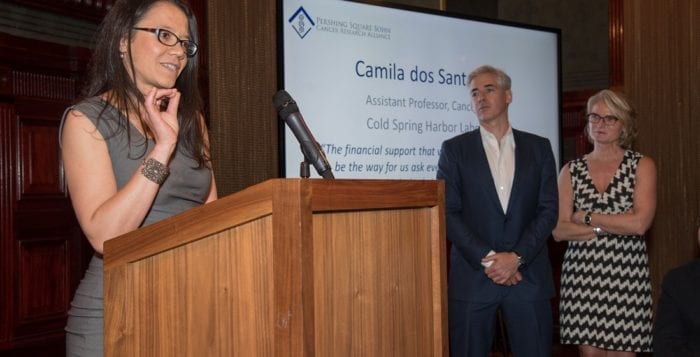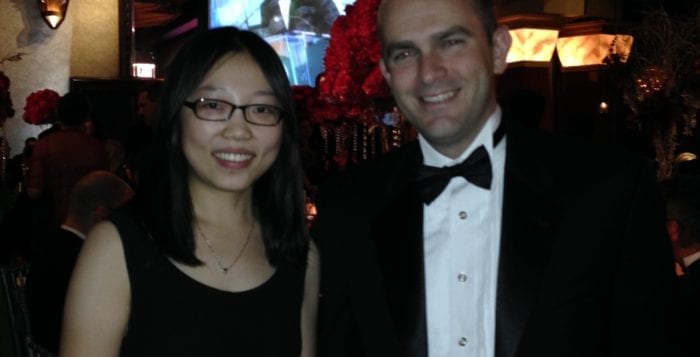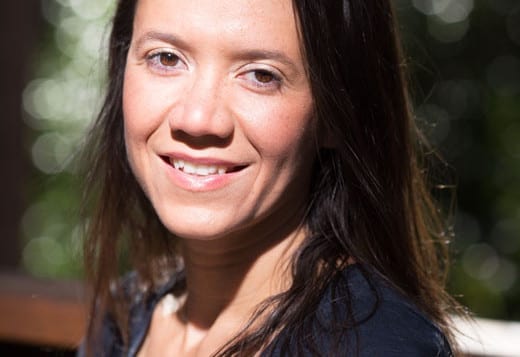By Daniel Dunaief
It is the type of miraculous conversion that doesn’t involve religion, and yet it may one day lead to the answer to passionate prayers from a group of people on a mission to help sick children.
Researchers in the lab of Professor Christopher Vakoc at Cold Spring Harbor Laboratory have been working tirelessly to understand the fundamental biology of Rhabdomyosarcoma, or RMS, which is a type of connective tissue cancer that afflicts between 400 and 500 people each year in the United States, with more than half receiving the diagnosis before they turn 10 years old.
As a part of her PhD research, Martyna Sroka searched for a way to convert the processes involved in this cancer into something benign.
Using a gene editing tool enhanced by another former member of Vakoc’s lab, Sroka disrupted a signal she had spent years trying to find in a protein called NF-Y, causing cancerous cells in a dish to differentiate into normal muscle cells, a conversion that offers future promise for treatment.
Sroka, who is now working as a scientist in a biotechnology company focused on the development of oncology drugs, described how RMS cells look small and round in a microscope. After disrupting this protein, the “differentiated cells become elongated and spindle-like, forming those long tubular structures,” she explained.
She often grew cells on plastic dishes and the differentiated RMS cells spanned the entire diameter of a 15 centimeter plate, providing a striking visual change that highlighted that conversion.
While this research represents an important step and has created considerable excitement in the scientific community and among families whose philanthropic and fundraising efforts made such a discovery possible, this finding is a long way from creating a new treatment.
Other research has indicated that disrupting NF-Y could harm normal cells. A potential therapeutic alteration in NF-Y could be transient and would likely include follow ups such as a surgical, radiation or biological approach to remove the converted RMS cells, Vakoc explained.
Nonetheless, the research, which was published in August in the prestigious Proceedings of the National Academy of Sciences, offers a potential roadmap for future discoveries.
“It was a long journey and being able to put the pieces of the puzzle together into a satisfying mechanism, which might have broader implications not only for our basic understanding of the biology of the disease but also for potential novel therapeutic approaches, was extremely exciting and rewarding,” said Sroka.
“It’s great to see so much excitement in the pediatric cancer field, and I am hoping that with time it will translate to much-needed novel therapeutic options for pediatric patients.”
The search
Cancer signals typically involve rewiring a cell’s genetic material, turning it into a factory that creates numerous, unchecked copies of itself.
Sroka and Vakoc were searching for the kind of signal that might force those cells down what they hope is a one-way differentiation path, turning those otherwise dangerous cells into more normal muscle cells that contract.
To find this NF-Y gene and the protein it creates, Sroka, who started working in Vakoc’s lab in the summer of 2017, screened over a 1,000 genes, which Vakoc described as a “heroic effort.”
Encouraged by this discovery and as eager to find new clinical solutions as the families who helped support his research, Vakoc recognizes he needs to strike a balance between trumpeting this development and managing expectations.
Interactions with the public, including families who have or are confronting this health threat, “comes with a lot of responsibility to make sure we’re being as clear as possible about what we’ve done and what have yet to do,” said Vakoc. “It’s going to be a long and uncertain road” to come up with new approaches to this cancer.
Funding families
Some of the families who provided the necessary funding for this work shared their appreciation for the commitment that Vakoc, Sroka and others have made.
“We are very excited about the newest paper [Vakoc and Sroka] published,” said Phil Renna, the Senior Director of Communications at CSHL and Director of the Christina Renna Foundation, which he and his wife Rene formed when their daughter Christina, who passed away at the age of 16, battled the disease. The Christina Renna Foundation has contributed $478,300 to Vakoc’s lab since 2007.
“In just a few short years, he has made a major leap forward. This lights the path of hope for us and our cause,” said Renna.
Renna explained that the lab has had numerous inquiries about this research. He and others recognize that the search for a cure or treatment involves “tough, grinding work” and that considerable basic research is necessary before the research can lead to clinical trials or new therapeutics.
Paul Paternoster, whose wife Michelle succumbed to the disease and who has raised funds, called Vakoc and Sroka “brilliant and incredibly hard working,” and suggested the exciting results “came as no surprise.”
He is “extremely pleased” with the discovery from the “standpoint of what it can lead to, and how quickly it was discovered.”
Paternoster, President of Selectrode Industries Inc., which manufactures welding products and has two factories in Pittsburgh, suggested that this strategy can have implications for other soft tissue sarcomas as well.
The next steps
To build on the discoveries Sroka made in his lab, Vakoc plans to continue to use a technique Junwei Shi, another former member of his lab, developed after he left CSHL and joined the University of Pennsylvania, where he is now a tenured professor.
Shi, whom Vakoc called a “legend” at CSHL for honing the gene editing technique called CRISPR for just this kind of study, is also a co author in this paper.
In future research, Vakoc’s lab plans to take the screens Sroka used to find NF-Y to search to the entire human genome.
“That’s how the family tree of science operates,” said Vakoc. Shi “made a big discovery of CRISPR and has since continued to create new technology and that he is now sharing back” with his lab and applying it to RMS. Additionally, Vakoc plans to expand the testing of this cellular conversion from plastic dishes to animal models
Shi, who worked in Vakoc’s lab from 2009 to 2016 while he earned his PhD at Stony Brook University, expressed satisfaction that his work is paying dividends for Vakoc and others.
“It just feels great that [Vakoc] is still using a tool that I developed,” said Shi in an interview. Many scientists in the field are using it, he added.
For Shi, who was born and raised in southern China, working at Cold Spring Harbor Laboratory fulfilled a lifelong dream.
He recalled how he retrieved data one Saturday morning that indicated an interesting pattern that might reveal the power of a new methodology to improve CRISPR screening.
When Vakoc came to the lab that morning, Shi shared the data, which was a “whole turning point,” Shi said.
Shi said he appreciates how CSHL has been “a home for me,” where he learned modern molecular biology and genetics.
When he encounters a problem in his lab, he often thinks about how Vakoc would approach it. Similarly, Vakoc suggested he also reflects on how his mentor Gerd Blobel, who is a co-author on the recent paper and is at the Children’s Hospital of Philadelphia, would respond to challenges.
As for the family members of those eager to support Vakoc, these kinds of scientific advances offer hope.
When he started this journey, Renna suggested he would feel satisfied if researchers developed a cure in his lifetime. This paper is the “next step in a marathon, but it makes us very excited,” he said.
To share the encouraging results from Vakoc’s lab with his daughter, Renna tacked up the PNAS paper to the wall in Christina’s bedroom.

